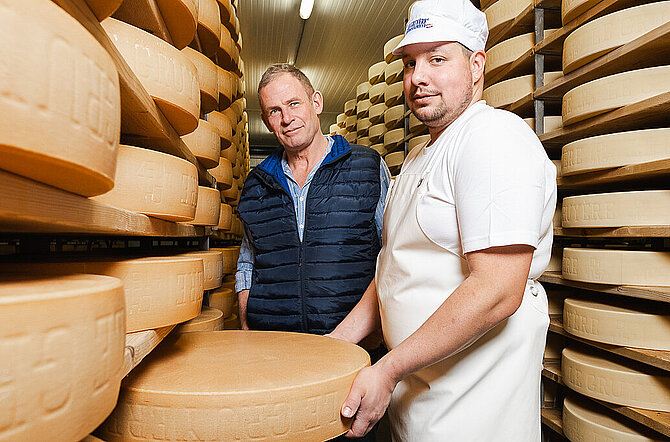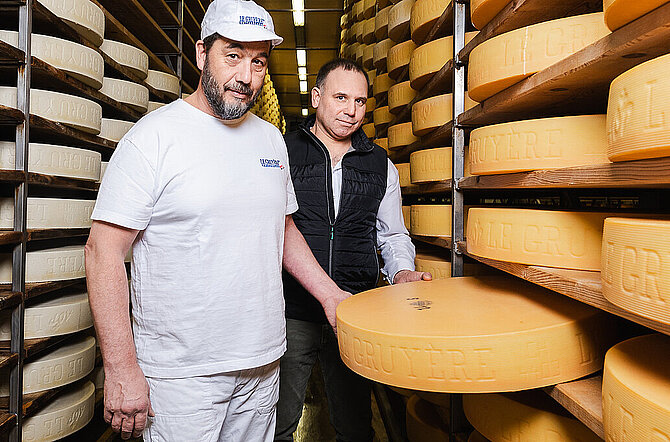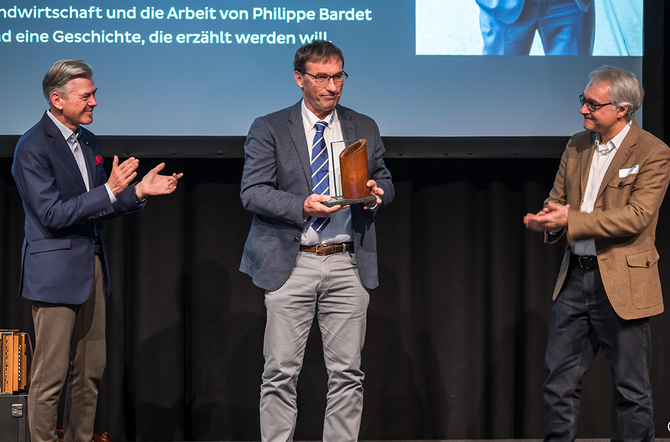A season on the mountain pasture: “Here, everything seems more beautiful.”
It’s a summer morning at Alpage de la Moesettaz in Le Brassus (Vaud) and the sun has not yet risen. For some time now, the fire has been crackling under the boilers filled with heated milk. A hushed silence falls as Martial Rod carefully cuts the curds. The paste begins to form, promising a perfect blend of flavour and suppleness. Between his precise movements, the mountain farmer shares his passion for life in this region and its flower-strewn pastures.

“Producing Le Gruyère d’Alpage AOP makes me proud. It’s a tradition that’s close to my heart”.
Martial Rod, cheesemaker at the Moesettaz mountain pasture
Martial Rod, up here in the mountain pastures, would you say you're a 'seasonal cheese-maker'?
If you like! I make Le Gruyère d'Alpage AOP every day from May to October, usually alongside my son Yannick. At 4 a.m., while he takes the cows out, I immerse the previous day's cheese in the salt bath.” We then set to work using the milk from the previous evening and the morning. The curds are put in at 5.30 am. We have until around 10 am to make our four daily wheels. We then move on to the maturing room. From milking the cows to making the cheese, there are no robots here! We make Le Gruyère AOP! Brushing the cheese every day allows us to monitor its development: it's important for a living product. The production process accounts for 50% of the result; the rest takes place during the refining process.
What distinguishes Le Gruyère d’Alpage AOP from a lowland Le Gruyère AOP?
Specific rules apply to the production of Le Gruyère d'Alpage AOP: the milk is heated over a wood fire, the whey is drained by hand, and the wheels are pressed in hemp cloths. They weigh between 25 and 30 kilos. We turn them by hand at the end of the morning and in the evening. With automation, young cheese-makers are no longer used to this traditional process.
Our cows graze on rich pastures with a wide variety of flowers and pretty clover. The quality of the milk and the flavour of Le Gruyère AOP are enhanced by this, which gives it a hint of hazelnut. I avoid excessive salt in the production process precisely to enhance this fruity flavour. But it also depends on the summer: this year is very flowery. In comparison, last year we had to feed our cows mainly dry fodder, because there was so little water.
Your Le Gruyère d'Alpage AOP has won several awards...
The most recent award was for best hard cheese at the OLMA Alpine Cheese Competition, held at the Swiss Agriculture and Food Fair in St Gallen. That was in 2023. My Le Gruyère d'Alpage AOP also received the five-year distinction of best Le Gruyère d'Alpage AOP from the IPG in 2019, and in 2017 it was voted Le Gruyère AOP d'Etat in the Canton of Vaud. I take great pride in these distinctions, as they not only showcase the quality of our cherished traditional craftsmanship but also affirm the valuable investments made in the mountain pastures to produce and mature our cheese.
It's a short season, so what are the highlights?
Going up to the mountain pastures in May and coming back in October are rituals that we enjoy as a family, with our friends and those of our 3 children. The return journey is a joyful one, but the outward journey is even more fun! Here, everything seems more beautiful than in the lowlands: it's the perfect place for our cattle and the direct contact with nature fills us with good energy. I can't imagine living any other way. Perhaps it's because I was born here, following in the footsteps of my father, who was already an alpine cheese-maker.
Will your children continue the tradition?
We all hope so! My eldest has earned his farming diploma and already knows how to make Le Gruyère AOP. The second is still an apprentice. In time, they’ll share the farm and the mountain chalet. By then, I hope Le Gruyère AOP exports will be growing again! Maintaining or even increasing production will be one of their challenges. As for my daughter, she’s chosen a different path, but my granddaughter is growing up among the animals on the mountain pastures. The next generation is already on its way!
What is your connection with the IPG?
I represent Le Gruyère d’Alpage AOP among the cheese inspectors. That's how I know that the 20 points don't just go to the Fribourgeois! (laughs) On a more serious note, this experience has taught me a lot, particularly what I need to improve in terms of production and maturing.
A season in figures:
- 40 dairy cows and 5 boarders
- 178,000 kilos of milk processed into Le Gruyère d’Alpage AOP and raclette cheese
- 40 steres of wood to heat the boilers
- 500 wheels of cheese produced, i.e. 16 tonnes of Le Gruyère d’Alpage AOP






